height HYUNDAI KONA EV 2023 Owners Manual
[x] Cancel search | Manufacturer: HYUNDAI, Model Year: 2023, Model line: KONA EV, Model: HYUNDAI KONA EV 2023Pages: 548, PDF Size: 49.14 MB
Page 72 of 548
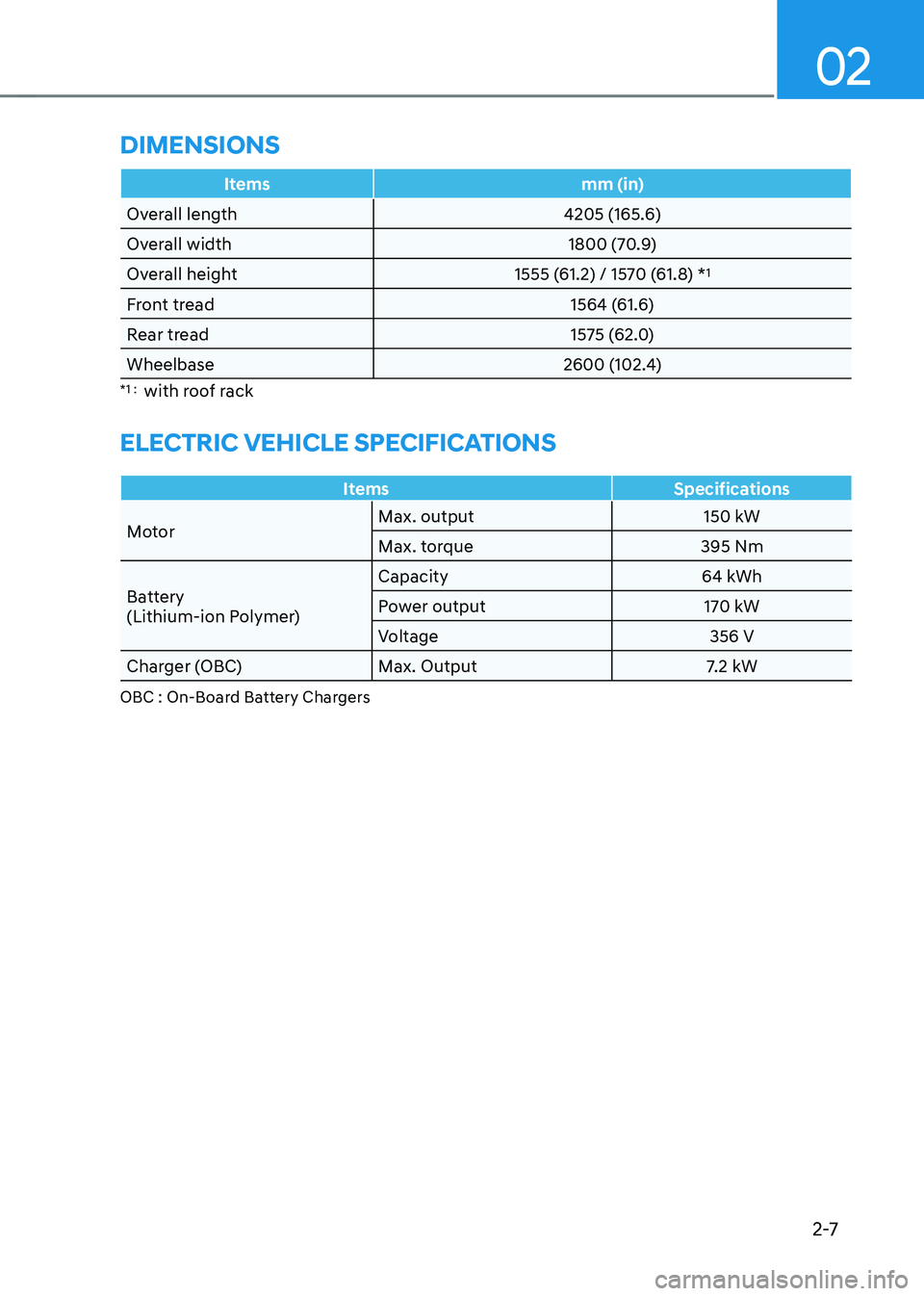
02
2-7
DiMensions
Itemsmm (in)
Overall length 4205 (165.6)
Overall width 1800 (70.9)
Overall height 1555 (61.2) / 1570 (61.8) * 1
Front tread 1564 (61.6)
Rear tread 1575 (62.0)
Wheelbase 2600 (102.4)
*1 : with roof rack
eLectric VeHicLe speciFications
Items Specifications
Motor Max. output 150 kW
Max. torque 395 Nm
Battery
(Lithium-ion Polymer) Capacity 64 kWh
Power output 170 kW
Voltage 356 V
Charger (OBC) Max. Output 7.2 kW
OBC : On-Board Battery Chargers
Page 82 of 548
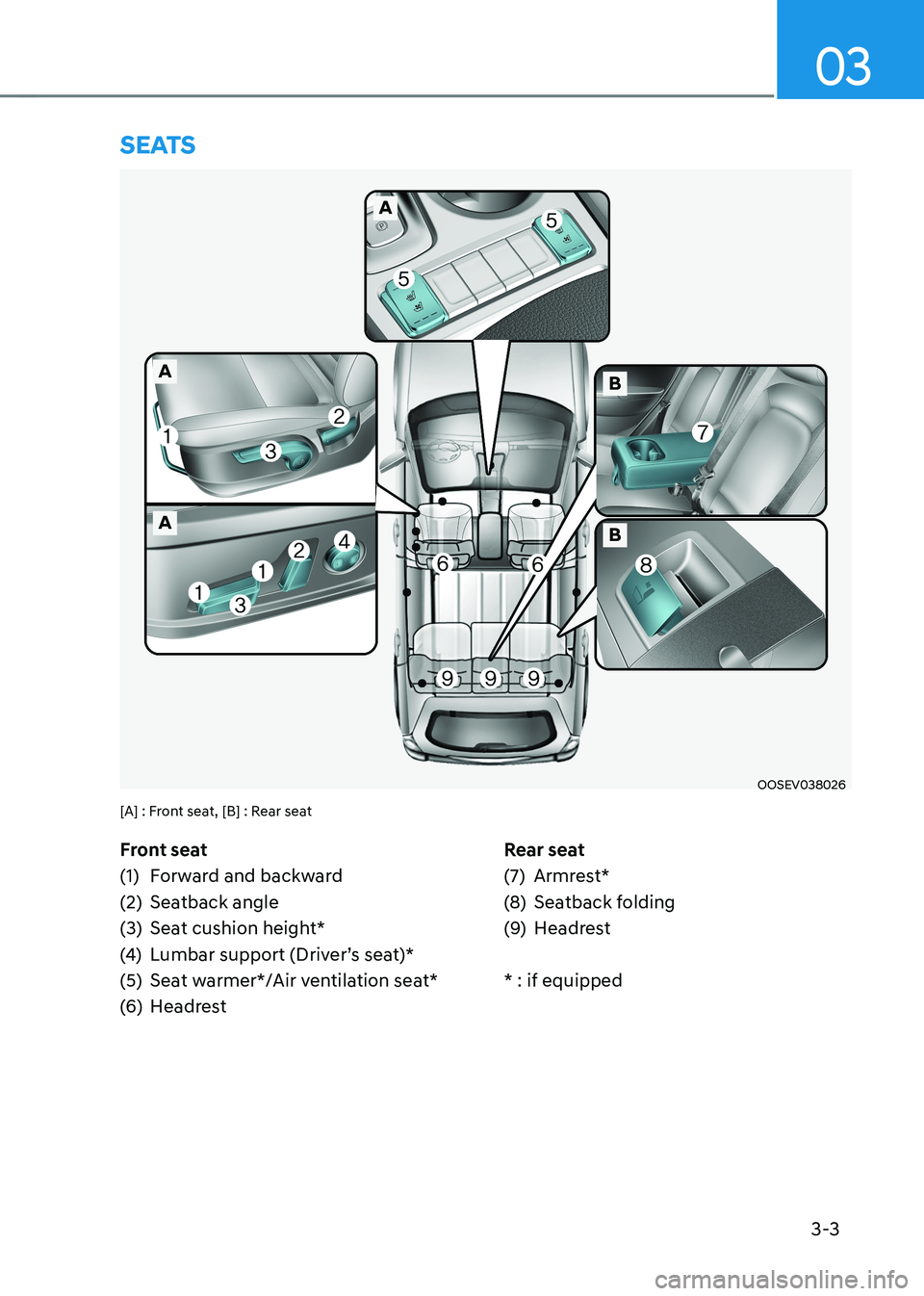
3-3
03
Front seat
(1) Forward and backward
(2) Seatback angle
(3) Seat cushion height*
(4) Lumbar support (Driver’s seat)*
(5) Seat warmer*/Air ventilation seat*
(6) Headrest Rear seat
(7) Armrest*
(8)
Seatback folding
(9) Headrest
* : if equipped
seats
OOSEV038026
a
a
B
aB
[A] : Front seat, [B] : Rear seat
Page 86 of 548
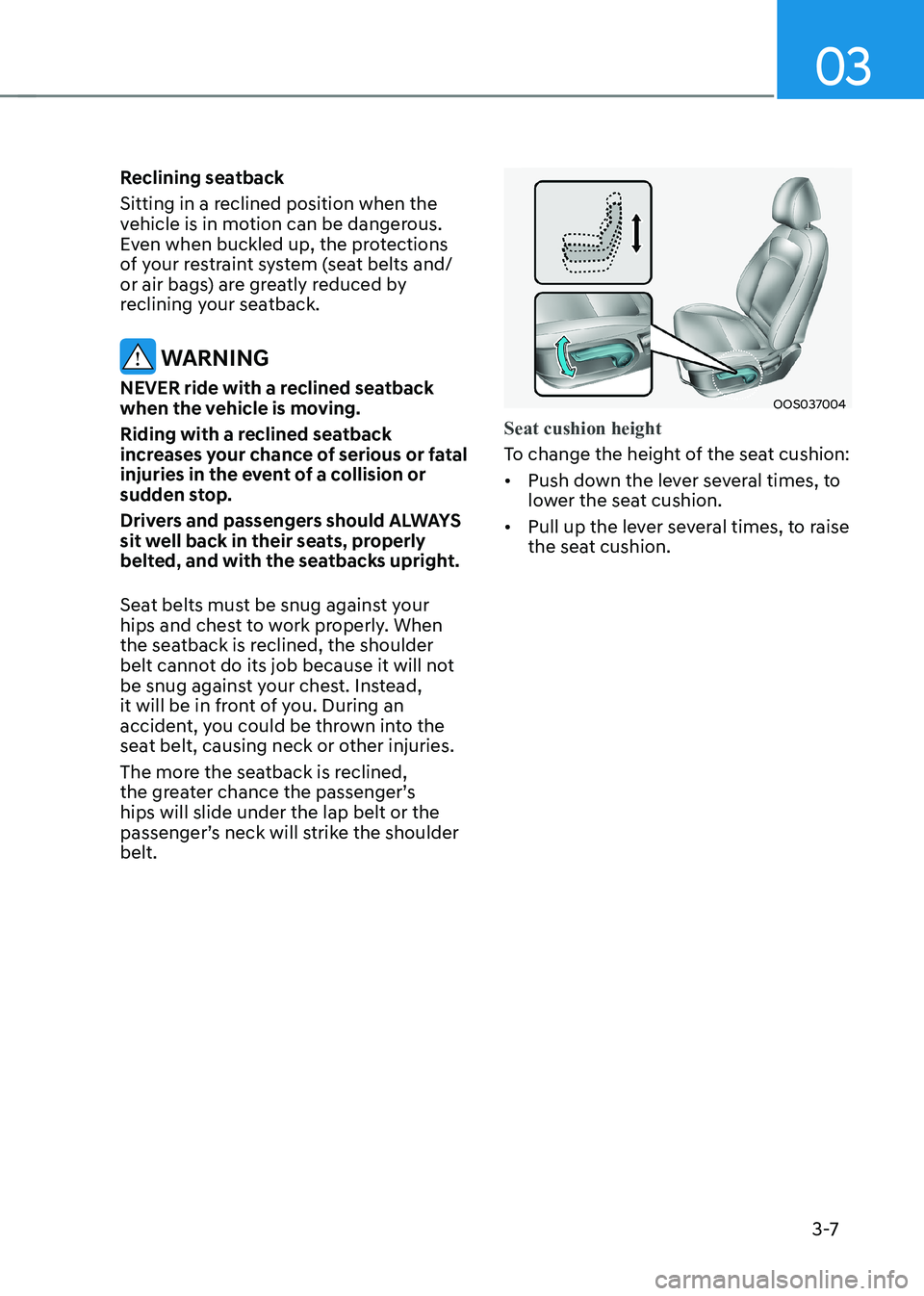
03
3 -7
Reclining seatback
Sitting in a reclined position when the
vehicle is in motion can be dangerous.
Even when buckled up, the protections
of your restraint system (seat belts and/
or air bags) are greatly reduced by
reclining your seatback.
WARNING
NEVER ride with a reclined seatback
when the vehicle is moving.
Riding with a reclined seatback
increases your chance of serious or fatal
injuries in the event of a collision or
sudden stop.
Drivers and passengers should ALWAYS
sit well back in their seats, properly
belted, and with the seatbacks upright.
Seat belts must be snug against your
hips and chest to work properly. When
the seatback is reclined, the shoulder
belt cannot do its job because it will not
be snug against your chest. Instead,
it will be in front of you. During an
accident, you could be thrown into the
seat belt, causing neck or other injuries.
The more the seatback is reclined,
the greater chance the passenger’s hips will slide under the lap belt or the
passenger’s neck will strike the shoulder belt.
OOS037004
Seat cushion height
To change the height of the seat cushion: • Push down the lever several times, to
lower the seat cushion.
• Pull up the lever several times, to raise
the seat cushion.
Page 88 of 548
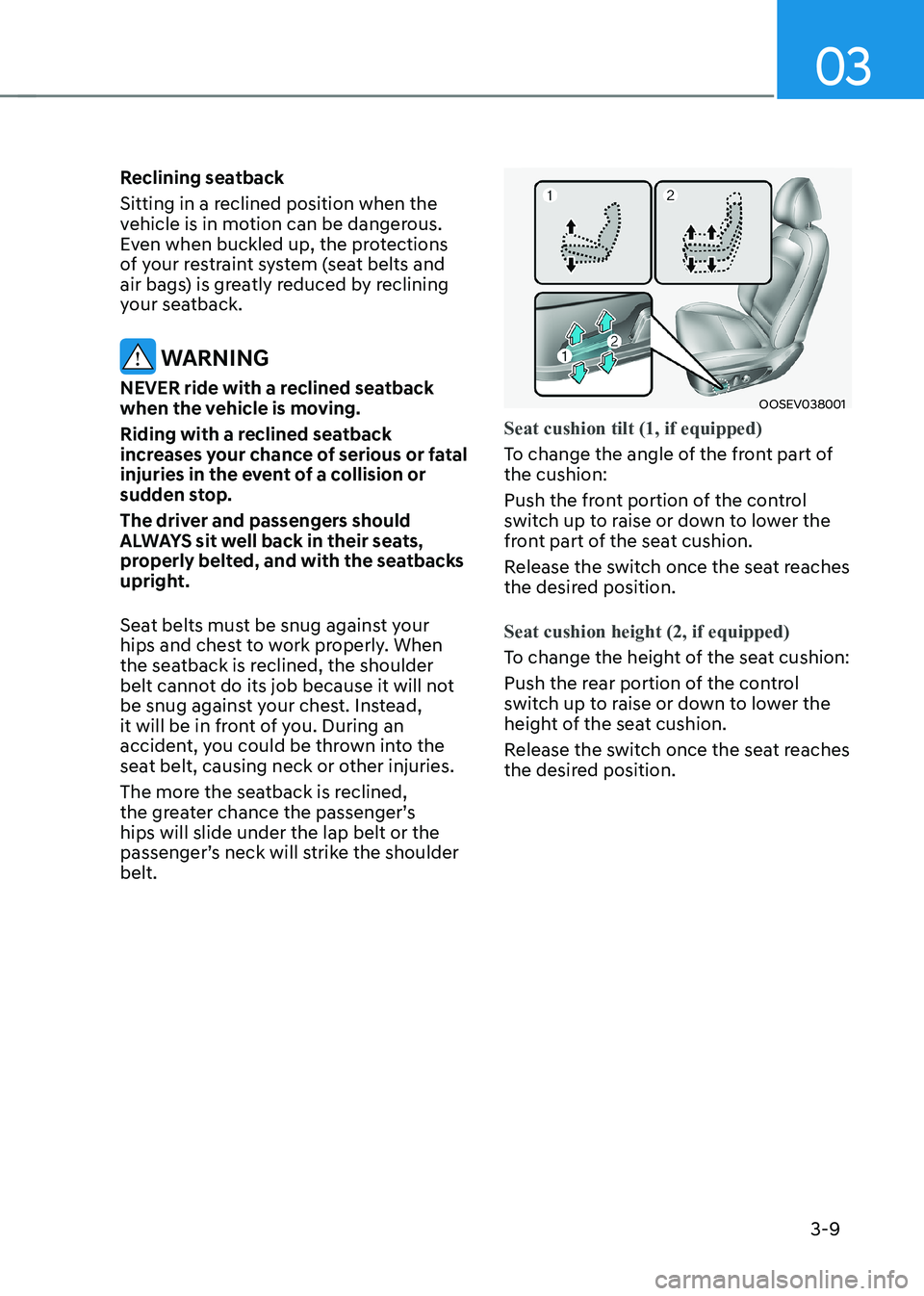
03
3-9
Reclining seatback
Sitting in a reclined position when the
vehicle is in motion can be dangerous.
Even when buckled up, the protections
of your restraint system (seat belts and
air bags) is greatly reduced by reclining
your seatback.
WARNING
NEVER ride with a reclined seatback
when the vehicle is moving.
Riding with a reclined seatback
increases your chance of serious or fatal
injuries in the event of a collision or
sudden stop.
The driver and passengers should
ALWAYS sit well back in their seats,
properly belted, and with the seatbacks
upright.
Seat belts must be snug against your
hips and chest to work properly. When
the seatback is reclined, the shoulder
belt cannot do its job because it will not
be snug against your chest. Instead,
it will be in front of you. During an
accident, you could be thrown into the
seat belt, causing neck or other injuries.
The more the seatback is reclined,
the greater chance the passenger’s hips will slide under the lap belt or the
passenger’s neck will strike the shoulder belt.
OOSEV038001
Seat cushion tilt (1, if equipped)
To change the angle of the front part of the cushion:
Push the front portion of the control
switch up to raise or down to lower the
front part of the seat cushion.
Release the switch once the seat reaches
the desired position.
Seat cushion height (2, if equipped)
To change the height of the seat cushion:
Push the rear portion of the control
switch up to raise or down to lower the
height of the seat cushion.
Release the switch once the seat reaches
the desired position.
Page 92 of 548
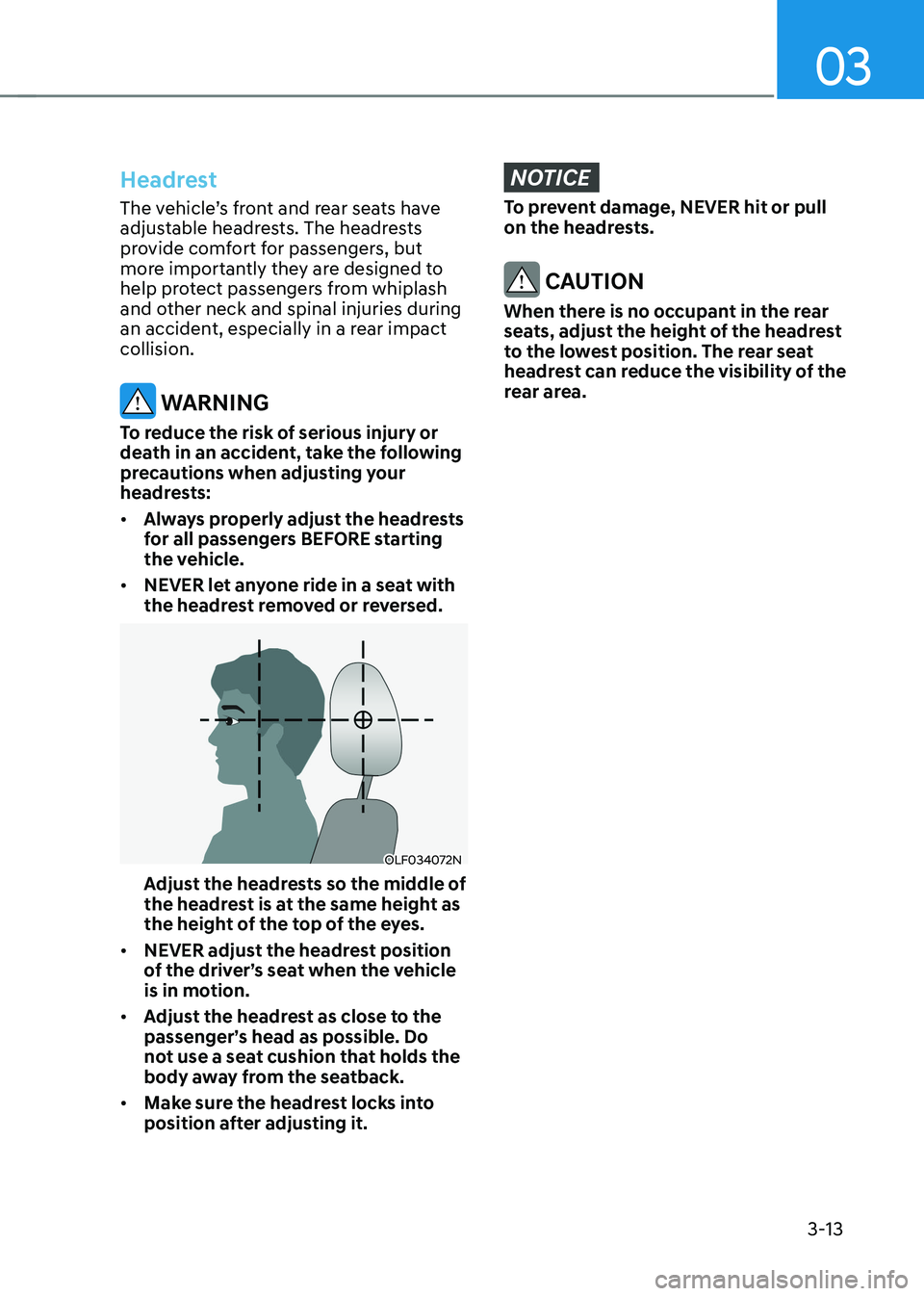
03
3-13
Headrest
The vehicle’s front and rear seats have
adjustable headrests. The headrests
provide comfort for passengers, but
more importantly they are designed to
help protect passengers from whiplash
and other neck and spinal injuries during
an accident, especially in a rear impact collision.
WARNING
To reduce the risk of serious injury or
death in an accident, take the following
precautions when adjusting your
headrests: • Always properly adjust the headrests
for all passengers BEFORE starting
the vehicle.
• NEVER let anyone ride in a seat with
the headrest removed or reversed.
OLF034072N
Adjust the headrests so the middle of
the headrest is at the same height as
the height of the top of the eyes.
• NEVER adjust the headrest position
of the driver’s seat when the vehicle
is in motion.
• Adjust the headrest as close to the
passenger’s head as possible. Do
not use a seat cushion that holds the
body away from the seatback.
• Make sure the headrest locks into
position after adjusting it.
NOTICE
To prevent damage, NEVER hit or pull
on the headrests.
CAUTION
When there is no occupant in the rear
seats, adjust the height of the headrest
to the lowest position. The rear seat
headrest can reduce the visibility of the
rear area.
Page 93 of 548
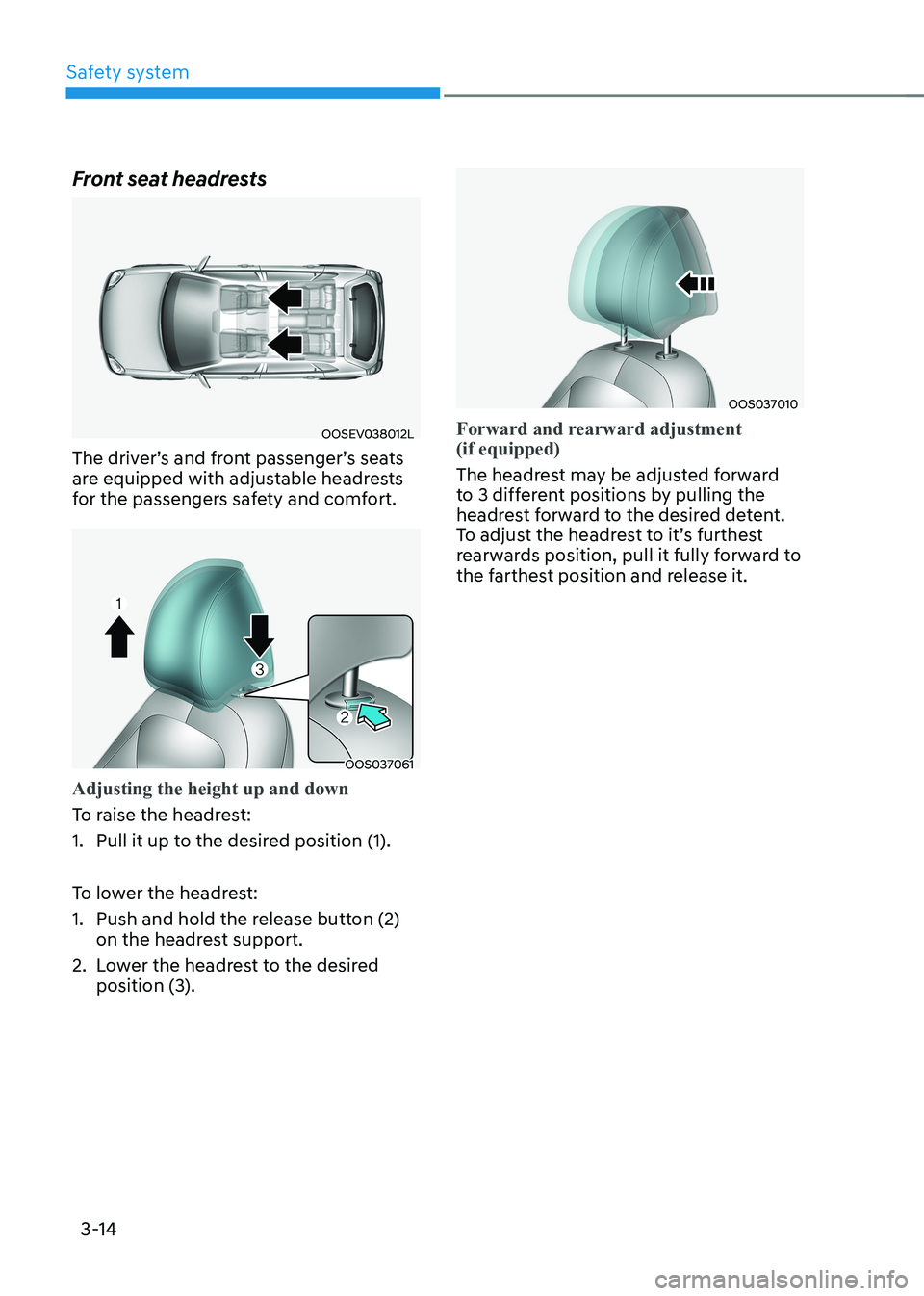
Safety system
3-14
Front seat headrests
OOSEV038012L
The driver’s and front passenger’s seats
are equipped with adjustable headrests
for the passengers safety and comfort.
OOS037061
Adjusting the height up and down
To raise the headrest:
1. Pull it up to the desired position (1).
To lower the headrest:
1. Push and hold the release button (2) on the headrest support.
2. Lower the headrest to the desired position (3).
OOS037010
Forward and rearward adjustment (if equipped)
The headrest may be adjusted forward
to 3 different positions by pulling the
headrest forward to the desired detent.
To adjust the headrest to it’s furthest
rearwards position, pull it fully forward to
the farthest position and release it.
Page 95 of 548
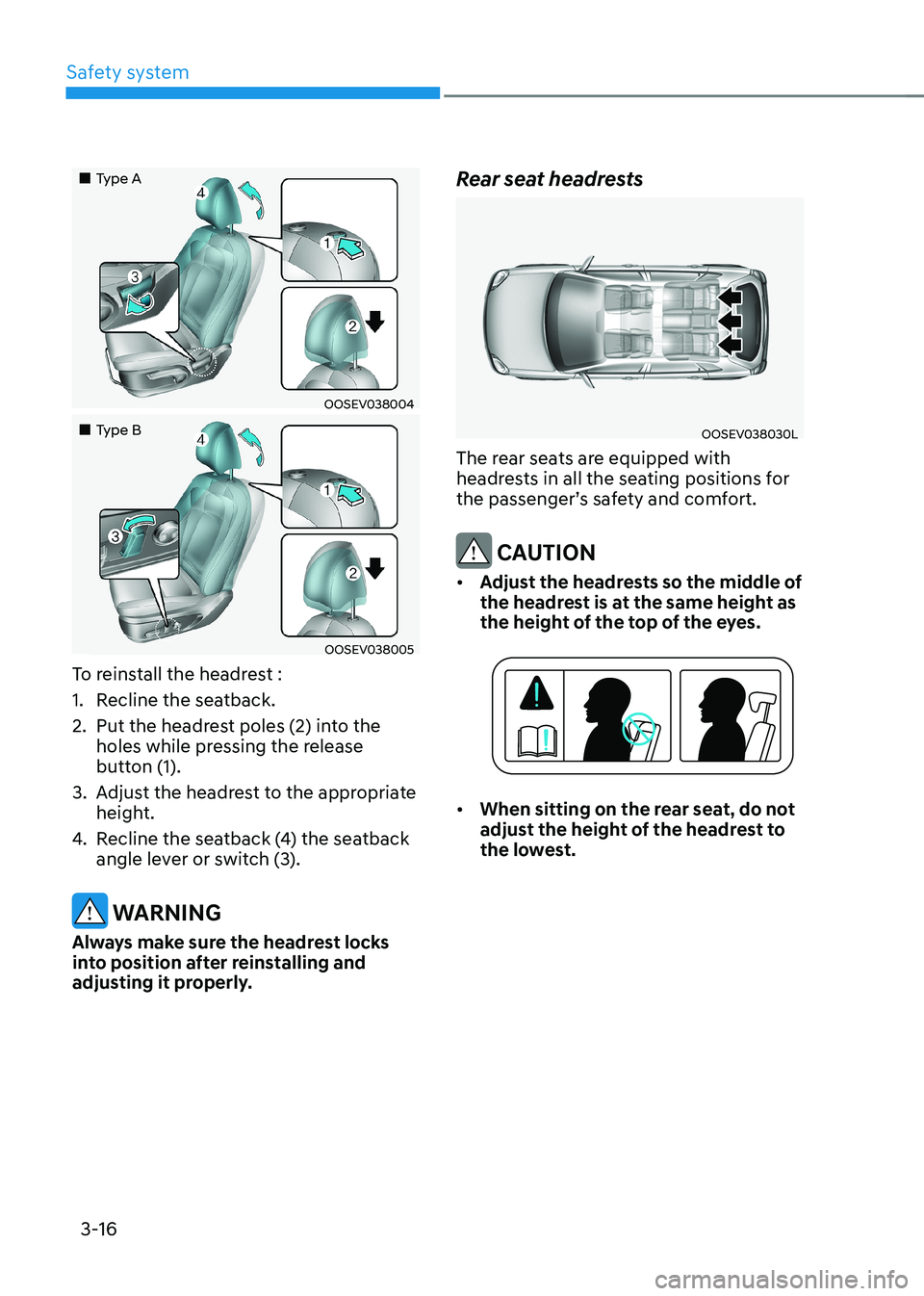
Safety system
3-16
„„Type A
OOSEV038004
„„Type B
OOSEV038005
To reinstall the headrest :
1. Recline the seatback.
2. Put the headrest poles (2) into the holes while pressing the release
button (1).
3. Adjust the headrest to the appropriate height.
4. Recline the seatback (4) the seatback
angle lever or switch (3).
WARNING
Always make sure the headrest locks
into position after reinstalling and
adjusting it properly. Rear seat headrests
OOSEV038030L
The rear seats are equipped with
headrests in all the seating positions for
the passenger’s safety and comfort.
CAUTION
• Adjust the headrests so the middle of
the headrest is at the same height as
the height of the top of the eyes.
• When sitting on the rear seat, do not
adjust the height of the headrest to
the lowest.
Page 96 of 548
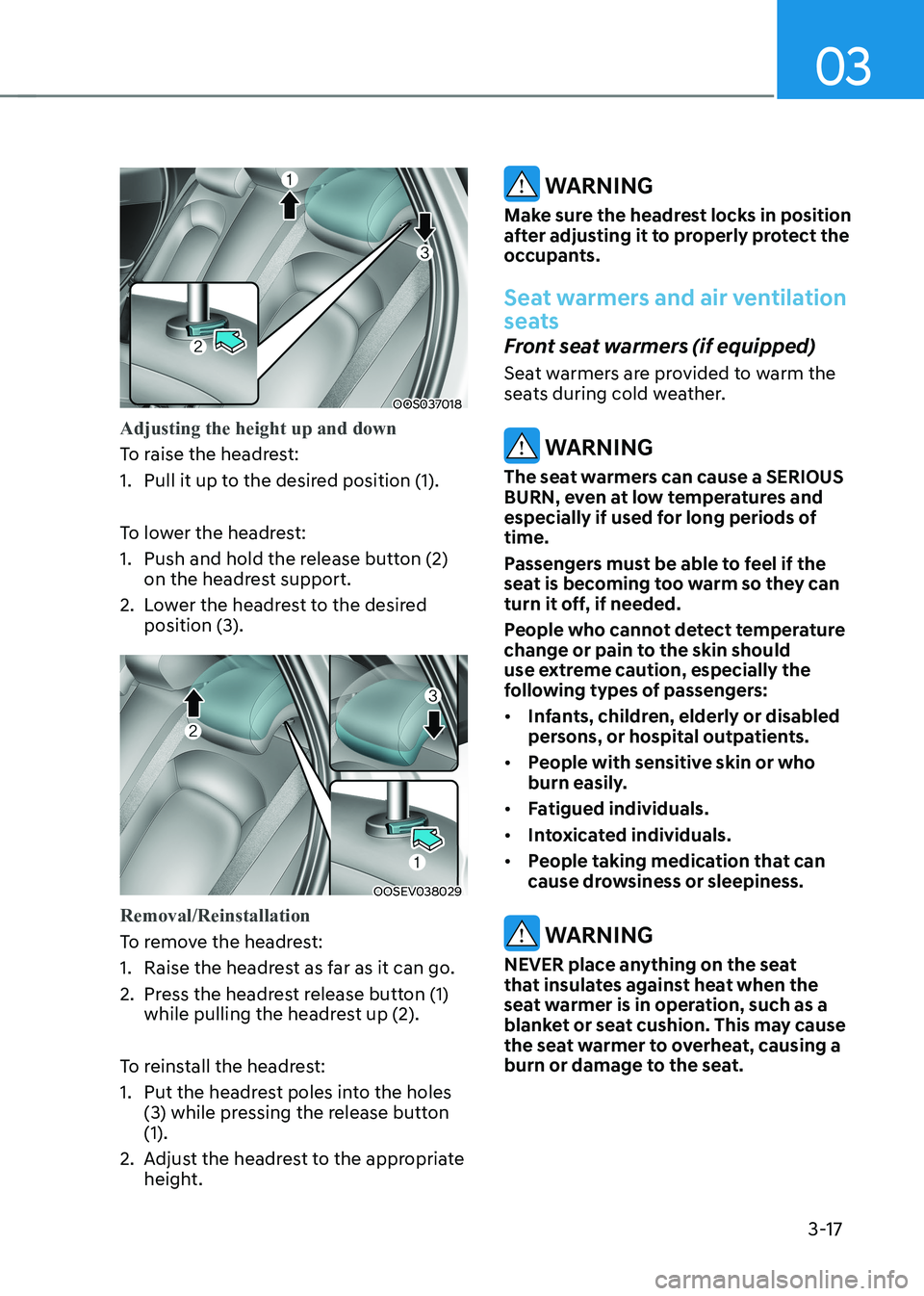
03
3-17
OOS037018
Adjusting the height up and down
To raise the headrest:
1. Pull it up to the desired position (1).
To lower the headrest:
1. Push and hold the release button (2) on the headrest support.
2. Lower the headrest to the desired position (3).
OOSEV038029
Removal/Reinstallation
To remove the headrest:
1. Raise the headrest as far as it can go.
2. Press the headrest release button (1) while pulling the headrest up (2).
To reinstall the headrest:
1. Put the headrest poles into the holes (3) while pressing the release button (1).
2. Adjust the headrest to the appropriate height.
WARNING
Make sure the headrest locks in position
after adjusting it to properly protect the
occupants.
Seat warmers and air ventilation
seats
Front seat warmers (if equipped)
Seat warmers are provided to warm the
seats during cold weather.
WARNING
The seat warmers can cause a SERIOUS
BURN, even at low temperatures and
especially if used for long periods of time.
Passengers must be able to feel if the
seat is becoming too warm so they can
turn it off, if needed.
People who cannot detect temperature
change or pain to the skin should
use extreme caution, especially the
following types of passengers: • Infants, children, elderly or disabled
persons, or hospital outpatients.
• People with sensitive skin or who
burn easily.
• Fatigued individuals.
• Intoxicated individuals.
• People taking medication that can
cause drowsiness or sleepiness.
WARNING
NEVER place anything on the seat
that insulates against heat when the
seat warmer is in operation, such as a
blanket or seat cushion. This may cause
the seat warmer to overheat, causing a
burn or damage to the seat.
Page 102 of 548
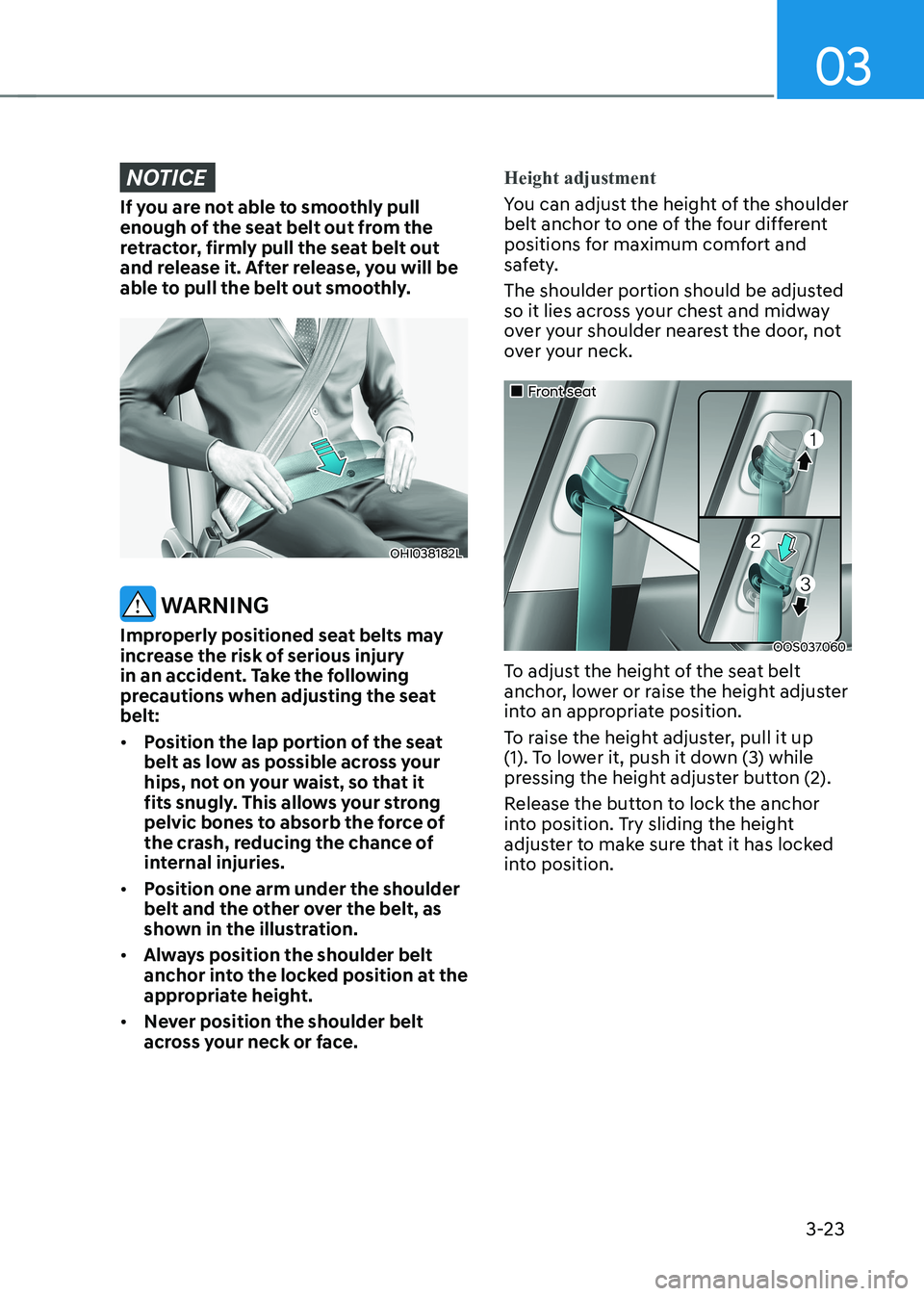
03
3-23
NOTICE
If you are not able to smoothly pull
enough of the seat belt out from the
retractor, firmly pull the seat belt out
and release it. After release, you will be
able to pull the belt out smoothly.
OHI038182L
WARNING
Improperly positioned seat belts may
increase the risk of serious injury
in an accident. Take the following
precautions when adjusting the seat belt: • Position the lap portion of the seat
belt as low as possible across your
hips, not on your waist, so that it
fits snugly. This allows your strong
pelvic bones to absorb the force of
the crash, reducing the chance of
internal injuries.
• Position one arm under the shoulder
belt and the other over the belt, as
shown in the illustration.
• Always position the shoulder belt
anchor into the locked position at the
appropriate height.
• Never position the shoulder belt
across your neck or face.
Height adjustment
You can adjust the height of the shoulder
belt anchor to one of the four different
positions for maximum comfort and
safety.
The shoulder portion should be adjusted
so it lies across your chest and midway
over your shoulder nearest the door, not
over your neck.
„„Front seat
OOS037060
To adjust the height of the seat belt
anchor, lower or raise the height adjuster
into an appropriate position.
To raise the height adjuster, pull it up
(1). To lower it, push it down (3) while
pressing the height adjuster button (2).
Release the button to lock the anchor
into position. Try sliding the height
adjuster to make sure that it has locked
into position.
Page 107 of 548
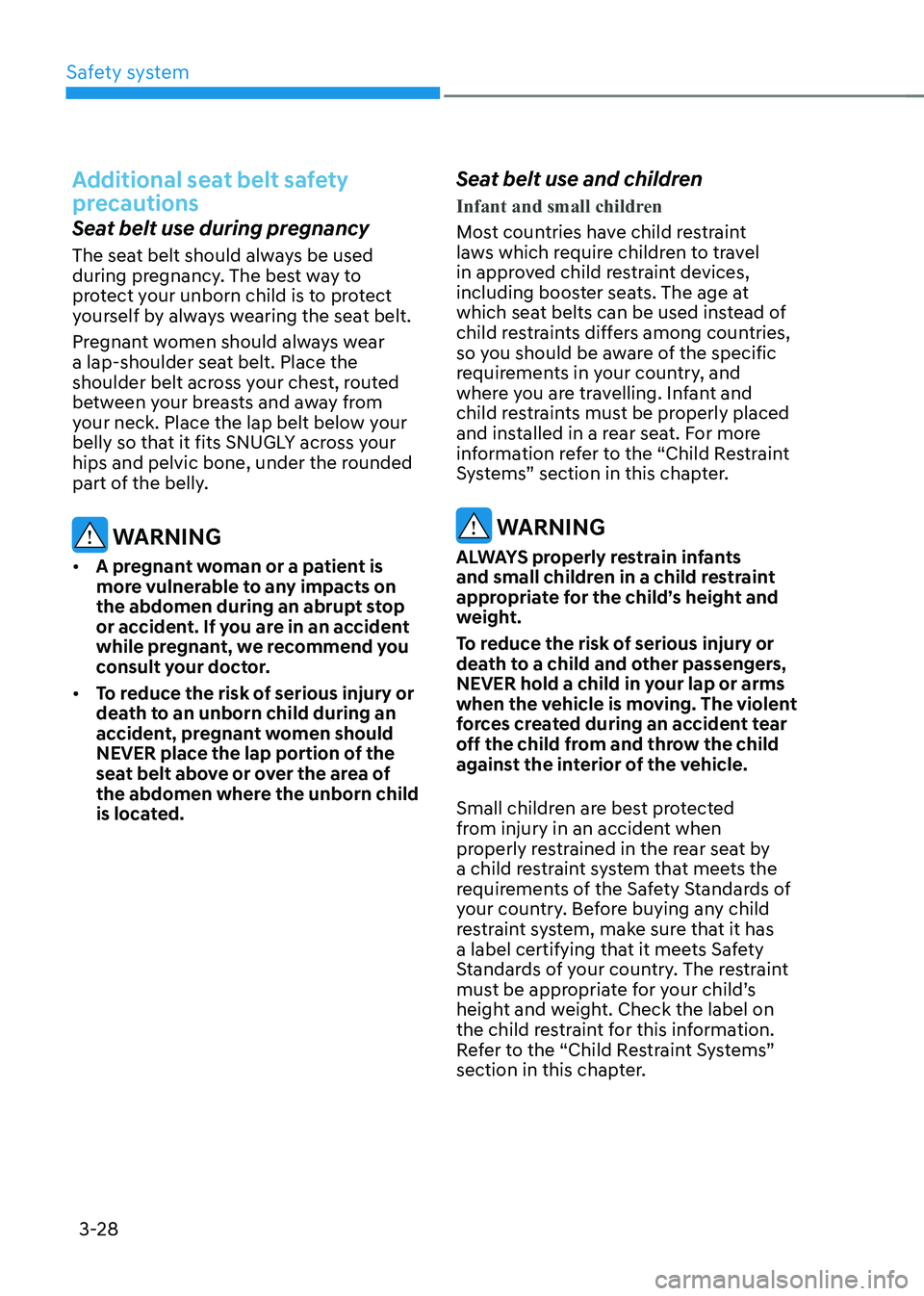
Safety system
3-28
Additional seat belt safety
precautions
Seat belt use during pregnancy
The seat belt should always be used
during pregnancy. The best way to
protect your unborn child is to protect
yourself by always wearing the seat belt.
Pregnant women should always wear
a lap-shoulder seat belt. Place the
shoulder belt across your chest, routed
between your breasts and away from
your neck. Place the lap belt below your
belly so that it fits SNUGLY across your
hips and pelvic bone, under the rounded
part of the belly.
WARNING
• A pregnant woman or a patient is
more vulnerable to any impacts on
the abdomen during an abrupt stop
or accident. If you are in an accident
while pregnant, we recommend you
consult your doctor.
• To reduce the risk of serious injury or
death to an unborn child during an
accident, pregnant women should
NEVER place the lap portion of the
seat belt above or over the area of
the abdomen where the unborn child
is located. Seat belt use and children
Infant and small children
Most countries have child restraint
laws which require children to travel
in approved child restraint devices,
including booster seats. The age at
which seat belts can be used instead of
child restraints differs among countries,
so you should be aware of the specific
requirements in your country, and
where you are travelling. Infant and
child restraints must be properly placed
and installed in a rear seat. For more
information refer to the “Child Restraint
Systems” section in this chapter.
WARNING
ALWAYS properly restrain infants
and small children in a child restraint
appropriate for the child’s height and
weight.
To reduce the risk of serious injury or
death to a child and other passengers,
NEVER hold a child in your lap or arms
when the vehicle is moving. The violent
forces created during an accident tear
off the child from and throw the child
against the interior of the vehicle.
Small children are best protected
from injury in an accident when
properly restrained in the rear seat by
a child restraint system that meets the
requirements of the Safety Standards of
your country. Before buying any child
restraint system, make sure that it has
a label certifying that it meets Safety
Standards of your country. The restraint
must be appropriate for your child’s
height and weight. Check the label on
the child restraint for this information.
Refer to the “Child Restraint Systems”
section in this chapter.